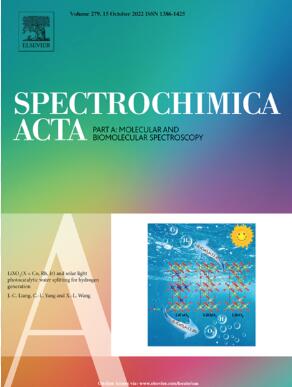Detection of Hg2+ in environmental water conditions by using a reusable SERS-based microfluidic chip with a high specificity and sensitivity
IF 4.3
2区 化学
Q1 SPECTROSCOPY
Spectrochimica Acta Part A: Molecular and Biomolecular Spectroscopy
Pub Date : 2025-02-17
DOI:10.1016/j.saa.2025.125912
引用次数: 0
Abstract
This work reported a surface-enhanced Raman spectroscopy (SERS)-based microfluidic chip that detects mercury ions (Hg2+) in water with high sensitivity and good reproducibility. Silver nanoparticles (AgNPs) are easily fabricated on a Si substrate using a thin, thermally treated Ag film. Cy3 functionalized single-stranded DNA (Cy3-ssDNA) serves as the probe, which is immobilized on the AgNPs (Cy3-ssDNA/AgNPs), generating a SERS-based sensing surface. Due to the strong interaction between thymine (T) bases and Hg2+, in the presence of these ions, the ssDNA forms a T-Hg2+-T hairpin structure, which enhances the SERS signal. This method exhibits a limit of detection (LOD) of 1 × 10−13 M. Furthermore, the proposed SERS chip demonstrates exceptional selectivity for mercury ions, as well as good reusability. The reusability of the SERS microfluidic chip was evaluated using the L-cysteine, which has a stronger affinity than T for Hg2+. By applying L-cysteine, the chip can be reused 10 times for the detection of Hg2+ at concentrations as low as 1 × 10−8 M. The method proposed in this study shows good sensitivity and holds good potential for application in the detection of Hg2+.

这项研究报告了一种基于表面增强拉曼光谱(SERS)的微流控芯片,它能以高灵敏度和良好的重现性检测水中的汞离子(Hg2+)。银纳米粒子(AgNPs)可在硅基底上使用热处理过的银薄膜轻松制作。Cy3 功能化单链 DNA(Cy3-ssDNA)作为探针,固定在 AgNPs(Cy3-ssDNA/AgNPs)上,形成一个基于 SERS 的传感表面。由于胸腺嘧啶(T)碱基和 Hg2+ 之间的强相互作用,在这些离子存在的情况下,ssDNA 形成 T-Hg2+-T 发夹结构,从而增强了 SERS 信号。这种方法的检测限(LOD)为 1 × 10-13 M。此外,所提出的 SERS 芯片对汞离子具有优异的选择性和良好的可重复使用性。我们使用 L-半胱氨酸评估了 SERS 微流控芯片的可重复使用性,L-半胱氨酸对 Hg2+ 的亲和力比 T 更强。通过使用 L-半胱氨酸,该芯片可以重复使用 10 次,检测浓度低至 1 × 10-8 M 的 Hg2+。
本文章由计算机程序翻译,如有差异,请以英文原文为准。
求助全文
约1分钟内获得全文
求助全文
来源期刊
CiteScore
8.40
自引率
11.40%
发文量
1364
审稿时长
40 days
期刊介绍:
Spectrochimica Acta, Part A: Molecular and Biomolecular Spectroscopy (SAA) is an interdisciplinary journal which spans from basic to applied aspects of optical spectroscopy in chemistry, medicine, biology, and materials science.
The journal publishes original scientific papers that feature high-quality spectroscopic data and analysis. From the broad range of optical spectroscopies, the emphasis is on electronic, vibrational or rotational spectra of molecules, rather than on spectroscopy based on magnetic moments.
Criteria for publication in SAA are novelty, uniqueness, and outstanding quality. Routine applications of spectroscopic techniques and computational methods are not appropriate.
Topics of particular interest of Spectrochimica Acta Part A include, but are not limited to:
Spectroscopy and dynamics of bioanalytical, biomedical, environmental, and atmospheric sciences,
Novel experimental techniques or instrumentation for molecular spectroscopy,
Novel theoretical and computational methods,
Novel applications in photochemistry and photobiology,
Novel interpretational approaches as well as advances in data analysis based on electronic or vibrational spectroscopy.

 求助内容:
求助内容: 应助结果提醒方式:
应助结果提醒方式:


